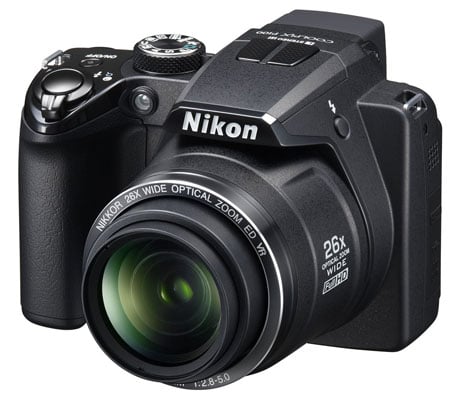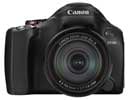Nikon COOLPIX P100
-
-
Written by Gordon Laing
Verdict
The Nikon COOLPIX P100 replaces the popular P90 super-zoom, extending the zoom reach from 24 to 26x and increasing the resolution of its 3 inch screen to 460k pixels. But by far the biggest change is the image sensor. In a bold move, Nikon has replaced the P90’s 12 Megapixel CCD sensor with a 10 Megapixel back-illuminated CMOS sensor. The drop in image resolution is more than made up for, though, with 1080p HD video recording and a wealth of high speed still and movie capture options.
This is a competitive market and the P100 faces stiff competition from rivals Panasonic and Canon. The P100 will have to ovecome some prejudices and preconceptions about the value of high-resolution sensors if it is to do well against models with a 4 Megapixel ‘advantage’. The P100’s CMOS sensor gives it high speed shooting features that, on paper at least, compare with those of Panasonic’s more expensive Lumix FZ100. And it’s lighter and slightly more compact than rival super-zooms.
 |
Compared to Panasonic Lumix FZ45 / FZ100
The COOLPIX P100 and Lumix FZ45 / FZ40 are very closely matched in price and there’s every chance that if you’ve been researching the super-zoom market you’ll have ended up with these two models on your shortlist. So which one to go for? First, the obvious things. The COOLPIX has a little more reach at the telephoto end of the zoom and the Lumix FZ45 / FZ40 an extra 4 megapixels. But even if you’re a sports or wildlife shooter, the difference between 600 and 678mm isn’t going to make a huge difference. As for the resoution, unless you plan to print your images A2 size it isn’t worth worrying about.
The P100’s articulated screen is an advance on the fixed screen of the FZ45 / FZ40 but, again, it’s not a killer blow. You might be tempted by the COOLPIX P100’s ability to shoot 1080p HD video, or it’s fast continuous shooting and burst modes. Remember though, that although the top video resolution of the FZ45 / FZ40 is 720p, you can use the PASM exposure modes and the optical image stabilisation while recording. And in practice, we found the P100’s burst shooting hard to handle. If fast shooting is really important to you you might want to consider increasing your budget at looking at the Lumix FZ100.
Which brings us to a more general point, something which, in our view is equally as important as feature differences. These are two very different cameras in terms of handling. The Lumix FZ45 / FZ40 provides lots of physical controls, a Q.Menu for quick access to exposure, focus and other camera settings and good feedback and control when shooting in manual modes. The COOLPIX P100 by contrast has a much cleaner physical layout with fewer menu options. In auto modes it’s a much simpler camera to use, but if you like to use over-rides like exposure compensation, AE and AF lock and frequently go for semi auto, manual and scene modes in preference to full auto shooting, then the Lumix FZ45 / FZ40 is better equipped and designed for that kind of photography.
See our Panasonic Lumix DMC-FZ45 / FZ40 review for more details. You may also be interested in our Panasonic Lumix DMC-FZ100 review.
Compared to Canon PowerShot SX30 IS
Every comparison we make between the Canon PowerShot SX30 IS and other Super-zooms starts with the lens. The PowerShot SX30 IS 35x 24-840mm equivalent zoom and its reach advantage over other models simply can’t be ignored. Or can it? The COOLPIX P100’s lens extends to 678mm, that’s a very long telephoto by any standards and more than long enough for most photographer’s needs. If you need the extra reach of the SX30 IS you’ll know it, in which case the rest is unimportant.
So what else is there that might decide you in favour of the PowerShot SX30 IS? Like the Lumix FZ45 / FZ40 it has an extra 4 megapixels on the sensor – see our previous comments about why this might matter to you. It has a very nice fully articulated screen, it’s lower resolution than the COOLPIX, P100’s but looks just as good and you can twist and turn it in any direction, not just up or down. And, although the P100 offers a top video reolution of 1080p, As with the FZ45 / FZ40 the Powershot’s ability to activate optical image stabilisation during video recording might prove more useful.
Lastly, of course, there’s the question of price. The COOLPIX P100 is considerably cheaper than the PowerShot SX30 IS, so the Canon’s extra resolution, extra zoom reach, articulated screen and let’s not forget the flash hotshoe, are all things you’re paying extra for. If these are important to you though, the PowerShot SX30 IS is one of the best super-zoom cameras around right now.
See our Canon PowerShot SX30 IS review for more details.
Nikon COOLPIX P100 final verdict
The Nikon COOLPIX P100 looks similar to the P90 it replaces, but is, in fact, a very different camera. At its heart, the new 10 Megapixel back-illuminated CMOS sensor has very different qualities to the 12 Megapixel CCD sensor of it’s predecessor. For one thing it has a lower resolution, but unless you like to make big prints, that’s fairly inconsequential. The new sensor means new features, primarily 1080p HD video and fast continuous shooting and burst modes. Other improvements include a longer 26x optical zoom lens and a higher resolution 460K pixel screen which, as before, is double-hinged to allow folding up and down.
If you want fast burst shooting on a Panasonic super-zoom, you’ll have to pay a premium for the FZ100, so the opportunity to get this feature on the P100, priced similarly to the FZ100’s cheaper sibling the FZ45 / FZ40 is an enticing prospect. In use, though, we found the P100’s burst modes to be hard to handle on account of the lack of visual feedback – if you can ‘t see what you’re shooting your chances of capturing it aren’t good regardless of the fps speed. And while it’s great to have 1080p video on a super-zoom in this price range, the lack of stabilisation is a disappointment.
One thing we weren’t disappointed by though was the P100’s image quality. The lens/sensor combination turned in good results across the board and did particularly well in our high ISO noise tests, for once providing evidence that back-lit CMOS sensors can deliver better high ISO noise performance.
In conclusion, the COOLPIX P100 is a bold move for Nikon, but a successful one. It provides advanced features that you’d need to pay considerably more for in models from other manufacturers, but you should be prepared to make some small compromises in return.
Bad points | Scores (relative to 2010 super-zooms) |
 | ||
Build quality: Image quality: Handling: Specification: Value:
Overall: |
17 / 20 17 / 20 16 / 20 17 / 20 18 / 20
85% | |||






